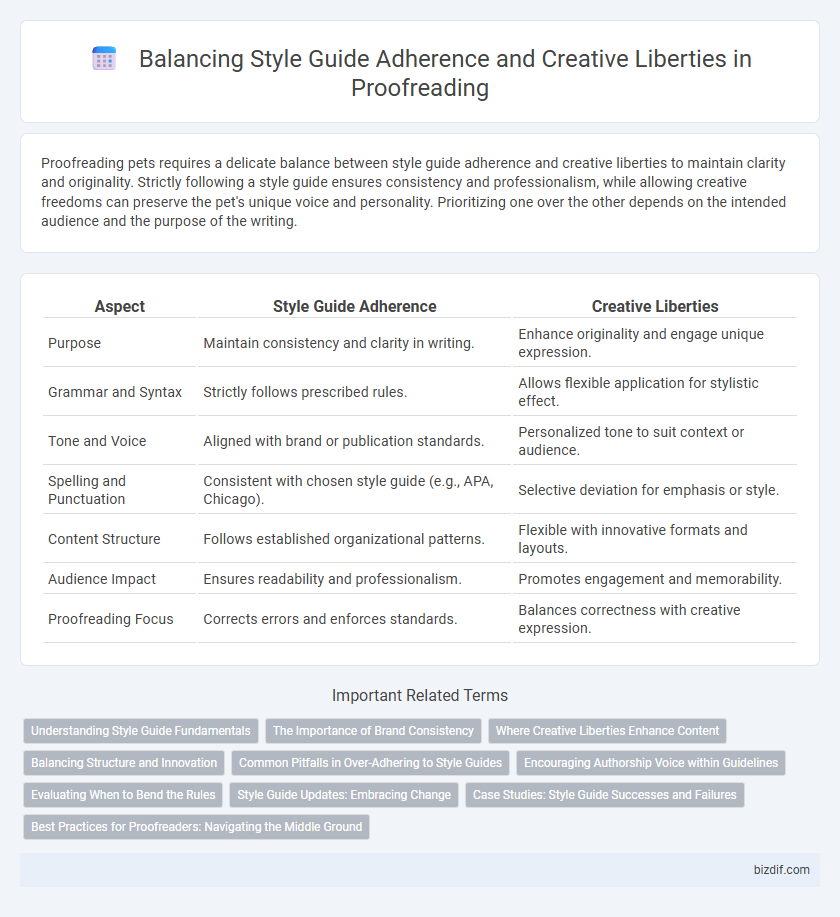Proofreading pets requires a delicate balance between style guide adherence and creative liberties to maintain clarity and originality. Strictly following a style guide ensures consistency and professionalism, while allowing creative freedoms can preserve the pet's unique voice and personality. Prioritizing one over the other depends on the intended audience and the purpose of the writing.
Table of Comparison
| Aspect | Style Guide Adherence | Creative Liberties |
|---|---|---|
| Purpose | Maintain consistency and clarity in writing. | Enhance originality and engage unique expression. |
| Grammar and Syntax | Strictly follows prescribed rules. | Allows flexible application for stylistic effect. |
| Tone and Voice | Aligned with brand or publication standards. | Personalized tone to suit context or audience. |
| Spelling and Punctuation | Consistent with chosen style guide (e.g., APA, Chicago). | Selective deviation for emphasis or style. |
| Content Structure | Follows established organizational patterns. | Flexible with innovative formats and layouts. |
| Audience Impact | Ensures readability and professionalism. | Promotes engagement and memorability. |
| Proofreading Focus | Corrects errors and enforces standards. | Balances correctness with creative expression. |
Understanding Style Guide Fundamentals
Understanding style guide fundamentals ensures consistency and clarity in writing by establishing standardized rules for grammar, punctuation, and formatting. Adhering to these guidelines enhances professionalism and accuracy, facilitating seamless communication across diverse audiences. Balancing style guide adherence with creative liberties involves maintaining structural coherence while allowing tailored expression to engage readers effectively.
The Importance of Brand Consistency
Adhering to a style guide ensures brand consistency by maintaining a uniform tone, voice, and formatting across all content, which strengthens brand recognition and trust. Creative liberties, while valuable for originality, must be balanced carefully to avoid diluting the brand's core identity or confusing the audience. Consistent application of brand guidelines in proofreading helps preserve the integrity of marketing materials and supports a cohesive brand narrative.
Where Creative Liberties Enhance Content
Creative liberties enhance content by injecting originality and personality that strict style guide adherence may limit, resulting in more engaging and memorable writing. Writers can use tailored tone, varied sentence structures, and vivid language to capture reader interest while maintaining clarity. Balancing creativity with essential style rules ensures content remains professional and accessible yet uniquely compelling.
Balancing Structure and Innovation
Balancing style guide adherence with creative liberties ensures clarity and originality in proofreading, maintaining brand consistency without stifling expression. Effective proofreading involves applying established rules while allowing nuanced language choices that enhance tone and engagement. This balance optimizes readability and preserves the writer's unique voice within structured guidelines.
Common Pitfalls in Over-Adhering to Style Guides
Strict adherence to style guides can stifle the natural flow and voice of the text, leading to robotic and less engaging content. Over-reliance on rigid rules often results in unnecessary repetition and awkward phrasing that disrupts readability. Balancing guideline compliance with creative flexibility ensures clarity while preserving the author's unique style and expression.
Encouraging Authorship Voice within Guidelines
Maintaining style guide adherence ensures consistency and clarity across all content while allowing room for the author's unique voice to shine enhances engagement and authenticity. Balancing strict compliance with creative liberties encourages writers to infuse personality and originality without sacrificing professionalism or readability. This approach fosters trust and connection with readers by blending structured guidelines with individualized expression.
Evaluating When to Bend the Rules
Evaluating when to bend style guide rules requires balancing consistency with creative expression, ensuring that deviations enhance clarity or engagement without compromising professionalism. Writers must consider audience expectations and the purpose of the text, determining if flexibility in grammar, punctuation, or tone strengthens the message. Thoughtful discretion in adhering to or diverging from style guidelines maintains both readability and originality.
Style Guide Updates: Embracing Change
Style guide updates reflect evolving language trends and industry standards, ensuring consistency and clarity in written content. Embracing these changes allows proofreaders to balance adherence to structured guidelines with the flexibility needed for creative expression. Maintaining this equilibrium enhances readability while preserving the writer's unique voice within the bounds of current style conventions.
Case Studies: Style Guide Successes and Failures
Case studies in proofreading reveal the critical balance between style guide adherence and creative liberties, highlighting how strict compliance ensures consistency and clarity, while selective deviations can enhance voice and engagement. Successful projects demonstrate meticulous application of established style protocols, reducing errors and boosting professionalism, whereas failures often stem from rigid enforcement that stifles originality or inconsistent rule application causing confusion. Analyzing these outcomes underscores the importance of adaptable proofreading strategies tailored to project goals and audience expectations.
Best Practices for Proofreaders: Navigating the Middle Ground
Proofreaders should balance strict adherence to style guides with allowing creative liberties to maintain the author's voice while ensuring clarity and consistency. Best practices include understanding when deviations serve readability without compromising grammatical standards and consulting style manuals alongside author preferences. This middle ground approach enhances text quality by blending precision with expressive freedom, crucial for professional proofreading services.
Style Guide Adherence vs Creative Liberties Infographic

 bizdif.com
bizdif.com